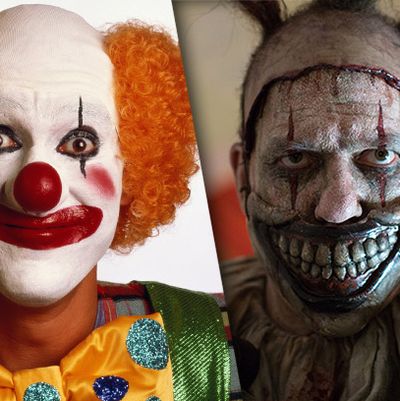
The clown community has a bit of a PR problem right now. First there was a freaky-deaky clown harassing people in a small California town. Then American Horror Story: Freak Show returned and brought with it a nightmarish clown. Halloween season is always a metaphorical tiny car surprisingly full of literal scary clowns, and there’s the ongoing problem of the Insane Clown Posse.
For Randy Christensen, this issue is no laughing matter. As president-elect of the World Clown Association, Christensen, who performs as Oxford P. Nuts, among other names, is serious about what constitutes real clowning — and scary stuff ain’t it.
We spoke with Christensen about the current fraught state of clowning and how people should understand the spate of frightening doppelgängers.
What do people need to understand about the problem with scary clowns?
Technically, I don’t even refer to horror clowns as clowns. They’re horror characters. American Horror Show [sic] — I think for the first season, they had Santa Claus with an ax. Is that what Santa’s really like? No. People use their imaginations different ways, but we’re proponents of good, clean, wholesome, family-friendly, cheerful comedy.
So scary clowns aren’t real clowns? Is that right?
People need to realize that there are different entertainment venues. We understand there’s a horror genre and some people really love being scared, but our goal is not to bring screams. Our goal is to bring laughs and smiles. Comic relief is something that encourages people, edifies people, helps relieve stress. The horror genre doesn’t relieve stress — it brings stress. So to be compared to Stephen King’s It is a false comparison. It’s like comparing apples and hamburgers.
You mentioned It. Did that open the scary-clown floodgates? Was it John Wayne Gacy? Why are scary clowns more prevalent than they were, say, 35 years ago?
I think It did start to turn things a little bit in American culture. You look back at the 1930s, ‘40s, ‘50s — you didn’t have television. The [1990] TV series It goes into every home in America on television. That has an impact.
Is Halloween season a frustrating time? There are just so many scary clowns out and about.
Yes. Just so you know, this is the eighth phone call I’ve had in five days about the subject.
Forget Halloween. There is something innately scary about clowns, right?
Ninety-five percent of people I’ve talked to that said they were afraid of clowns had something happen negatively when they were children. They felt like they were cornered by this character they didn’t understand. I think we all understand that when you can’t read somebody’s face, you don’t know how to connect with them. So we have the same situation with clowning as we do with Mickey Mouse at Disney World. Every kid loves Mickey Mouse — until he’s six feet tall and they’re supposed to give him a hug. They don’t know who’s behind the mask.
More broadly, how does the work of the World Clown Association fit into all this?
In the World Clown Association we take this seriously. We train people to create positive environments for their audiences. How do you approach people who might be afraid? First of all, we recommend that [they] don’t approach them. I’ve walked into a daycare with 40 3-year-olds, and I’ve found that about half of them are happy to see me, and the other 20 aren’t quite sure what to do. What I do is I interact with the 20 that are excited to see me, and let everybody else watch and see that I’m safe and I’m friendly and I’m happy and I’m playful. Before I leave, usually 39 out of the 40 will come over and shake my hand or give me a high-five or hug my legs. I did not force myself into their world, I opened the door so they could enter my world of play.
What would a scary clown do differently?
That’s the thing about the horror clown. The horror clown invades people’s space for shock value.
And that’s not what a real clown would do.
Again, we understand the horror genre, but that’s not what we do. I think that’s where people get this mixed up. The copycat clowns out in California — these are people finding some sick satisfaction in creeping people out. These are not clowns. These are people that dress up as horror characters. If you had a doctor at a haunted house standing there with a chainsaw, you understand he’s not really a doctor. We look at clowning in the same way. These horror clowns creep me out, and I’m a clown. Kids aren’t equipped to deal with those images.
I could never bring myself to watch It.
I’ve had people come to me and say, “I’ve been scared of clowns ever since I watched It as a child.” And I said, “Hold it. You saw It when you were a kid?” This is an R-rated movie!
The rating doesn’t matter: I’ll still never watch that movie.
I’d rather laugh. I’d rather have fun. That’s what real clowns do.

